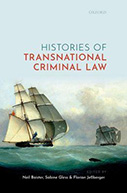Histories of Transnational Criminal Law

Editors: Neil Boister, Sabine Gless, and Florian Jeßberger
Publisher: Oxford University Press, 2021. 368 pages.
Reviewer: Gillian MacNeil ǀ June 2022
Different readers will find Histories of Transnational Criminal Law interesting for different reasons. For the criminal law specialist, details of evolving transnational crimes and procedures may be the most compelling aspects of the book. These developments have practical implications. Many domestic legal systems contain a presumption that local laws will be consistent with a state’s international legal obligations. In some jurisdictions, international norms have primacy. To ensure compliance with the presumption, or respect the hierarchy of norms, it is essential to know which domestic laws are rooted in international obligations. Criminal law specialists may be surprised to learn how many current criminal laws, once considered the core of a state’s sovereignty, are now established by international agreement. One of the inescapable lessons of this volume is that those agreements have been used to steadily expand the reach of criminal laws. This work also reminds us that, given the impact of criminal laws on individuals, it is important to engage critically with the substance of those laws; considering the lawmaking processes is one means of doing so.
“Laws, like sausages, cease to inspire respect in proportion as we know how they are made” (“News of the Day,” 1869). Or so warned 19th century poet John Godfrey Saxe in cautioning against inquiry into lawmaking processes. Legal scholar Lon L Fuller took a different view. Fuller argued that a sound lawmaking process is essential to the legitimacy of the law (Fuller, 1969). Fuller did not claim that a sound process would necessarily result in objectively ‘good’ laws. Rather, he argued that there was a greater likelihood that a sound process would generate sound outcomes (Fuller, 1969, pp. 155–56; see also Rundle, 2013, p. 96). On this logic, a conscientious lawmaker should invite scrutiny of the process because it will inspire respect, rather than the opposite. Histories details the evolution of TCL and enables us to assess the processes by which these laws were made, and the respect that the results should inspire. To create Histories, editors Neil Boister, Sabine Gless, and Florian Jeßberger gathered a group of distinguished authors who investigate the origins and evolution of transnational criminal law (TCL). These authors have crafted 22 carefully researched histories of transnational crimes, institutions, theory, and procedures. In doing so, the authors have opened the curtains on international lawmaking processes.
International lawmaking has previously been the subject of some academic commentary (e.g., Boyle & Chinkin, 2007). The authors of Histories do not repeat these earlier discussions, nor do they simply rehash existing works exploring the histories of transnational crimes. The goal underlying this volume is to collect the “histories of the evolution” of TCL frameworks (p. 2). In pursuing this goal, the authors engage with an impressive array of primary and secondary materials to excavate the histories. The results are a detailed and sometimes troubling look into transnational criminal laws, procedures, and institutions. Lawmakers and processes emerge as central to the histories.
For a long time, international lawmaking was carried out far from the view of states’ populations. This was probably of little import. Until the post–Second World War period, most international laws concerned relations between states (though even prior to the 20th century some laws directly affected individuals). In general, there was little need for individuals to be concerned about the international lawmaking process or its outcomes. This is no longer true. International criminal laws (e.g., genocide, crimes against humanity, and war crimes) now apply directly to individuals. Other international laws require states to implement obligations which may protect individuals (such as human rights laws) or impose responsibilities upon them. Among the latter are TCLs.
Transnational criminal laws are laws which require “the ‘suppression by international law through domestic penal law of criminal activities that have (i) actual or (ii) potential transboundary effects or (iii) transboundary moral impact’” (p. 3 (citing Boister, 2015, p. 13)). They address crimes which undermine shared international values (Boister, 2003). Since the conclusion of the Convention on Offences and Certain Other Acts Committed on Board Aircraft (1963), states have agreed to an increasing number of treaties (the suppression conventions) which require them to cooperate to quell transnational crimes. As Histories demonstrates, the roots of TCL are much older.
The volume is divided into three sections: “Chapters 1–7 are concerned with conceptual and institutional developments” (p. 7), “Chapters 8–17 cover histories of specific crimes” (p. 9) and “Chapters 19–22 examine procedure and jurisdiction” (p. 11). Each chapter contains a fascinating examination of the histories of TCL. The structure adopted by the editors is helpful to the reader, especially one who is not yet well versed in TCL. The first chapters ground the reader in domestic legal developments which informed the creation and expansion of TCL (pp. 14–26). This provides the foundation for the later discussions of the way specific crimes, procedures, and institutions evolved.
Histories demonstrates that TCL got off to a slow start. The building blocks of modern TCL are multilateral conventions (pp. 39–56). Early on, these were relatively rare. During the 19th century, the British used bilateral treaties to secure cooperation in their efforts to suppress the slave trade (pp. 128–37). More general agreements were harder to conclude. Despite its long history, states only clearly settled on a definition of piracy in 1982. They have still not agreed that it is a crime which they must criminalize in their domestic laws. This lack of harmonization has prevented the emergence of a duty to suppress piracy (pp. 115–27). Disagreements also hampered early 20th century efforts to bring into force frameworks for suppressing terrorism and human trafficking (pp. 138–61).
As with so much else in international law, the Second World War was a watershed. Histories shows that modern TCLs were developed by some of the same people and institutions so essential to the development of international criminal laws around the time of the Second World War (pp. 57–69). The important role played by individuals in the early development of TCL receives well-deserved attention in this volume (including a chapter devoted to the outsized role played by Gerhard Mueller) (pp. 70–83). The efforts of these individuals provided the foundation for later expansion, though modern TCL failed to incorporate mechanisms guaranteeing fair trial rights which had been a core concern of early reformists (pp. 27–38). It is only more recently that human rights (including fair trial rights) have begun to be reintroduced into the TCL system (pp. 300–18). If human rights received little attention in the development of TCL frameworks, expansion of liability did not.
The number of crimes which states have agreed to suppress continues to increase; frameworks for the illicit trade in cultural objects and cybercrimes are still developing (pp. 220–248). While there is no doubt that many of the crimes which are targeted by the suppression conventions are serious, Histories invites us to consider whether the continual expansion of TCL is justified (p. 234). This is a particularly important question because it is not just the number of crimes which have expanded; the scope of liability, jurisdictional reach of states, and obligations to cooperate have also grown. The suppression conventions now routinely require states to criminalize specified activities, cooperate in investigating crimes, prosecute or extradite individuals accused of these crimes, and seize the proceeds of crimes.
Over time, states increased the ambit of liability by expanding (and more clearly delineating) accomplice liability (pp. 249–60). The incorporation of overlapping mandatory and permissive jurisdictional rules in the suppression conventions makes it more likely that individuals will be caught in a web of enforcement. This was deliberate: states chose to adopt frameworks which would result in competing claims for jurisdiction rather than risk gaps in coverage (pp. 261–75). The consequence is that individuals may find themselves subject to prosecution in an increasing number of states, including states which they have never entered. The jurisdictional provisions are backed by obligations to extradite.
The more recent conventions all include articles which allow states to use the suppression conventions as extradition treaties. They create multilateral extradition relationships between states which may not have trusted each other’s systems sufficiently to have concluded bilateral extradition treaties (pp. 276–86). While this does not mean that states will necessarily use the multilateral conventions for extradition, the existence of these provisions raises that potential and possibly that expectation (though this is an area where human rights obligations impose some limitations) (pp. 314–16).
Histories show that these developments were not inevitable. It invites us to consider whether in their modern pragmatism, states may have strayed too far from the principled underpinnings which were part of the foundation of TCL.
Anybody interested in the degree of respect TCLs should inspire will find Histories invaluable. As described above, the book suggests some of the results are problematic and that the processes used do not always inspire confidence. Some of the suppression conventions were the result of processes which were heavily informed by particularly affected states (pp. 177–86). Among these, the United Nations Convention against Transnational Organized Crime (2000) stands out as a particularly well-received instrument: there are currently 190 parties to this treaty including major states often noted for their disagreements (e.g., China, Russia, and the United States).
Other modern conventions have more troubling pedigrees. Consensus on suppressing some activities was achieved only after states problematized those activities as criminal. As the history of migrant smuggling suggests, it is not clear that characterization is always warranted. Migrant smuggling was often resorted to by those fleeing oppression, persecution, or other devastating circumstances. While states had difficulty agreeing on responses to the humanitarian crises that resulted in migrant smuggling, they achieved consensus when migrant smuggling was re-characterized as a security threat (pp. 162–76).
Some instruments are the result of a group of like-minded states driving developments in accordance with their interests (pp. 187–201). The resulting mechanisms may not address the concerns of the most affected states (pp. 101–14, 202–19). The frameworks developed to combat corruption and impose corporate liability are not suited to address the illicit payments that the affected South American and African states wanted to suppress. Corruption was instead branded as a problem involving public authorities, limiting the suitability of the current frameworks to address the illicit payments which were the initial causes of concern (pp. 187–201).
Histories equally reveals the problematic development of TCL institutions. Not all efforts to create TCL institutions have succeeded. Despite the desire by some smaller states for the creation of a transnational criminal court, a type of institution with historical precedent, this has not attracted the support of more powerful states or those less impacted by transnational crimes which continue to view domestic courts as sufficient (pp. 101–14). Less formal processes have been used to create TCL institutions; this does not necessarily solve the problems which can arise in state-to-state processes. An historical look at the development of INTERPOL suggests it may be both unaccountable and vulnerable to political interference (pp. 287–99).
Histories of Transnational Criminal Law demonstrates that “[t]he development of transnational criminal law is influenced by a multitude of actors convening and interacting in a dazzling variety of settings, compositions, and manifestations” (p. 84). This variety complicates efforts to tell a comprehensive history, though Histories provides an excellent starting point. The contributors address different institutions, actors, and crimes, but the book remains a partial history. Some of the authors note the involvement of African and Arab rulers in the development of TCL (pp. 128–37). Others discuss the interests of (and roles played by) Central and South American or Caribbean states (pp. 101–14, 187–201). Overall, however, the histories and perspectives contained in this volume are largely Western European and North American. Further volumes incorporating additional perspectives would be a welcome development. Nonetheless, Histories reveals important insights into the evolution of TCL. It also suggests that Saxe and Fuller had a point. Examination of the lawmaking process can help us assess the degree of respect the results inspire: for some transnational criminal laws, that may be a problem.
References:
Boister, Neil. 2003. “Transnational Criminal Law?” European Journal of International Law. 14: 953–76.
-
- 2015. “Further Reflections on the Concept of Transnational Criminal Law.” Transnational Legal Theory. 6(1): 9–30.
Boyle, Alan & Chinkin, Christine 2007. The Making of International Law. Oxford University Press: Oxford, UK.
Convention on Offences and Certain Other Acts Committed on Board Aircraft. 1963, September 14.
Fuller, Lon L. 1965. The Morality of Law: Revised Edition. Yale University Press: New Haven, CT.
News of the Day. 1869, March 29. The Cleveland Daily Herald, 1.
Rundle, Kristen. 2013. Forms Liberate: Reclaiming the Jurisprudence of Lon L. Fuller. Hart Publishing: Oxford, UK.
United Nations Convention against Transnational Organized Crime. 2000, November 15.
Gillian MacNeil, Assistant Professor, Faculty of Law, University of Manitoba


